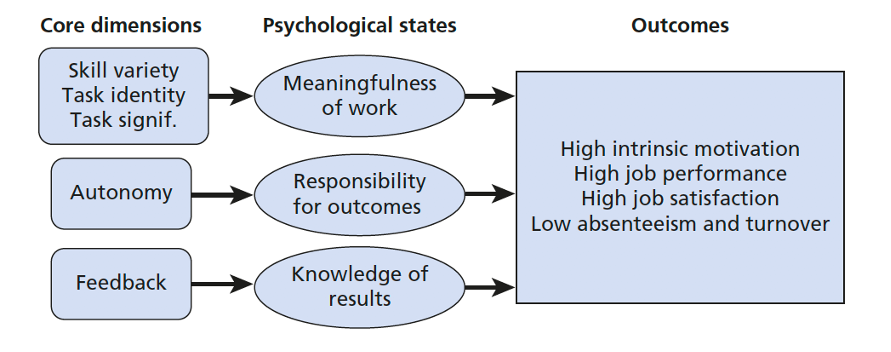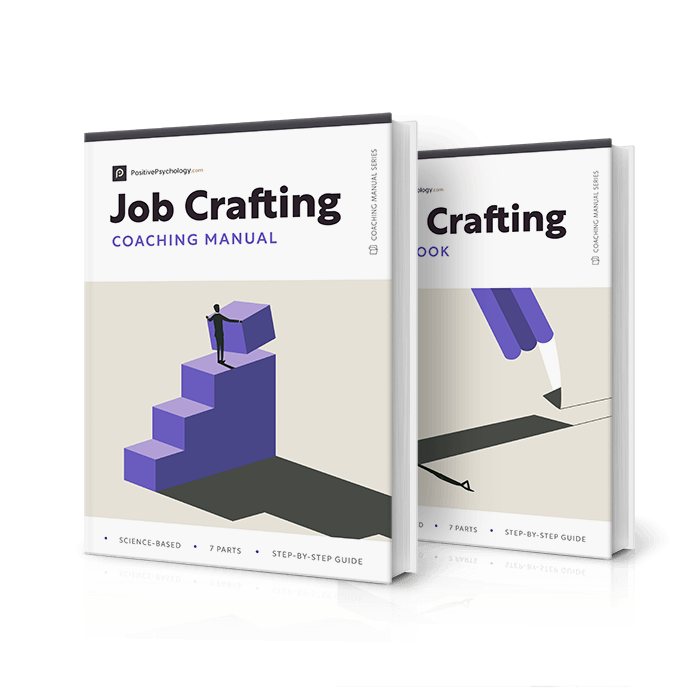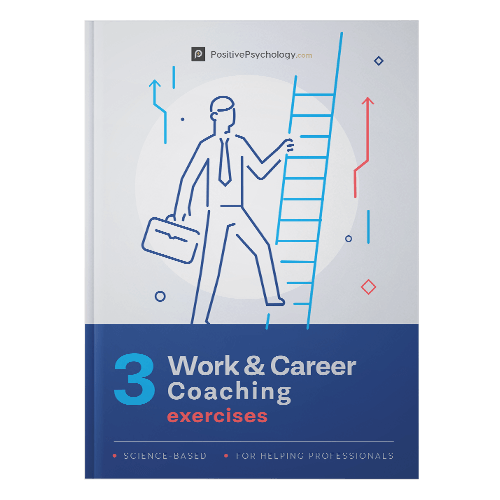Job Satisfaction Theory: 6 Factors for Happier Employees
 The field of job satisfaction is rich and multi-layered, peppered with definitions, concepts, and theories drawn from several disciplines.
The field of job satisfaction is rich and multi-layered, peppered with definitions, concepts, and theories drawn from several disciplines.
But why is it important to think about job satisfaction? Why is it important to try and optimize it?
For one, most people spend the bulk of their waking hours at work. So it might come as no surprise that not enjoying our jobs can translate into general dissatisfaction with life.
But beyond the individual level, organizations are thankfully starting to recognize the importance of paying attention to employee satisfaction. Moral imperatives aside, doing so has been linked to productivity and a reduction in absenteeism (Steptoe-Warren, 2013).
This article will look at job satisfaction theories, how it arises, and what this means for performance at work.
Before you continue, we thought you might like to download our three Work & Career Coaching Exercises for free. These detailed, science-based exercises will help you or your clients identify opportunities for professional growth and create a more meaningful career.
This Article Contains:
6 Theories About Job Satisfaction
Before diving into an overview of job satisfaction theory, it first helps to consider how job satisfaction is defined.
While there are numerous definitions, the consensus is that job satisfaction is a multidimensional psychological response with three main arms: cognitive, affective, and behavioral (Weiss, 2002). We form attitudes toward our job by interpreting our feelings, beliefs, and behaviors.
Bear these domains in mind while the following six job satisfaction theories are described; ideally, a complete theory will address them all at some level.
1. Locke’s range of affect theory
With origins in organizational psychology, Edwin Locke’s (1976) range of affect theory is perhaps the most well-recognized model of job satisfaction.
Locke’s theory recognized the importance of how much people value different aspects of their job, along with how well their expectations are met. In short, our values inform our expectations, and the closer these are to reality, the more satisfied we feel.
For instance, if person A greatly values a work culture of teamwork and collaboration, while person B regards this facet neutrally, person A is more likely to feel dissatisfied if this expectation isn’t met by their job.
But Locke argued that too much of a good thing also leads to job dissatisfaction. Taking the same example, if an emphasis on teamwork comes at the expense of time for solo work, person A (and person B) could have a negative experience of their job.
2. The dispositional approach
The next job satisfaction theory takes a different view. Outlined by Barry Staw and colleagues, the dispositional approach was formed in light of evidence that affective disposition predicts job satisfaction (Staw, Bell, & Clausen, 1986). They argued that people’s tendency to experience positive or negative emotions accounts for individual differences in job satisfaction.
Being limited by its largely empirical approach, the dispositional approach has faced criticism. Yet personality researchers have shown that personality traits remain largely stable over time, and the same is true with job satisfaction, even through different jobs and careers (Staw & Cohen-Charash, 2005).
Staw’s job satisfaction research stimulated spin-off theories. One of these is the Core Self-Evaluations Model, for which there is good evidence.
Researchers have demonstrated four self-evaluations mediating stability in job satisfaction, independent of job attributes (Judge, Locke, & Durham, 1998):
- Self-esteem: with higher levels linked to greater job satisfaction
- Self-efficacy: with higher levels linked to greater job satisfaction
- Locus of control: the tendency toward an internal rather than external locus of control is linked to job satisfaction
- Neuroticism: with lower levels linked to greater job satisfaction
3. The Job Characteristics Model
The Job Characteristics Model aims to specify conditions under which people are satisfied by their work and motivated to perform effectively (Hackman & Oldham, 1976).
With meta-analyses lending support for this job satisfaction theory (Fried & Ferris, 1987), it has become commonly used to examine characteristics of work leading to job satisfaction.
Five core characteristics have been reported, along with three psychological states acting as a sort of ‘gateway’ to satisfaction:
Source: Steptoe-Warren (Occupational Psychology, 2013, p. 174)
- Skill variety:
As the name implies, this characteristic refers to the presence of different kinds of challenges at work. - Task identity:
The degree to which a job calls for completion of discrete, ‘whole’ pieces of work. - Task significance:
Whether the job has substantial impact on the lives/work of other people. - Autonomy:
The degree of freedom or independence the job provides. - Feedback:
How clearly an individual is told about their performance.
4. Equity theory
Equity theory was outlined in the 1960s by workplace and behavioral psychologist John Stacey Adams (1965). He posited that jobs involve a continuous assessment of how much ‘give and take’ there is between employer and employee.
The basic premise of this model is that job satisfaction and motivation result from a fair balance between an employee’s ‘inputs’ and ‘outputs.’
Here are some common examples of inputs:
- Hard work
- Skill level
- Enthusiasm for the job
- Supporting colleagues
- Personal sacrifice
Common outputs include:
- Financial compensation
- Recognition and reputation
- Praise
- Job security
- Other intangible benefits
The greater the imbalance (or ‘inequity’) between the two, the less likely a strong, productive relationship will emerge between employer and employee. Besides, dissatisfaction can get worse if the ratio between inputs and outputs is deemed to be more imbalanced when compared to others.
This is what makes employees happy at work
5. The social information processing theory
This brings us to the next job satisfaction theory. As social creatures, human beings pay very close attention to the opinions and behaviors of the group. In other words, we’re not living in a vacuum.
Going back to theories of social comparison, people have a drive to look to others for information that helps generate a complete picture of themselves (Festinger, 1954). Couldn’t this also apply to job satisfaction?
Social information processing theory argues this case. With links to the sociological concept of ‘constructivism,’ it recognizes that people form a picture of reality by interacting with people around them.
According to this model, people might (consciously or unconsciously) scrutinize how their colleagues feel before deciding how they feel. As you’d expect, if coworkers feel positive about the work they do and the environment they’re in, a person is more likely to feel satisfied (Jex, 2002).
6. Self-determination theory (SDT)
Self-determination theory (SDT) emerged from the work of Edward Deci and Richard Ryan. As a macro theory successfully validated in many fields of intrinsic motivation and behavior, SDT is well placed to provide insight into job satisfaction.
In contrast with extrinsic motivation, where activities are pursued for an external goal, intrinsic motivation leads to the initiation of behavior for its own reward (Deci, 1971). This reward could be interest or satisfaction, for example.
According to SDT, people can assimilate extrinsic motivations into their core sense of self and value system, changing their behavioral framework.
On the back of this, three universal needs involved in self-determination have been recognized as essential to such integration: the need for competence, autonomy, and relatedness (Ryan & Deci, 2000).
SDT has led to important insights about work motivation and factors related to job performance, which will be discussed further below.
6 Proven Factors That Affect Job Satisfaction

As you read, you’ll likely notice many of them intersect. Different yet similar ideas often emerge, with many of them showing two-way patterns of cause and effect. This is due to concepts among various schools of thought overlapping.
1. Work that is engaging
A 2017 report from Gallup found that just 13% of the world’s workforce felt ‘engaged’ at work. But what does it mean for work to be engaging?
Engaging activities allow people to express their natural strengths and capitalize on their current skillset. Results from a large observational study of 60 career satisfaction studies spanning two decades (Todd, 2014) matched this line of thinking, adding that engaging work must provide a sense of ‘flow’ and hold the individual’s attention.
The study noted four other factors tied to job satisfaction in meta-analyses that make work engaging. You’ll notice these intersect with the Job Characteristics Model described earlier:
- Autonomy of work schedule/style
- Tasks are clear, with an obvious start and end point
- Task are varied
- Consistent feedback on performance is provided
2. Work that is meaningful
The same study (Todd, 2014) also highlighted that work entailing help or kindness to others can be a factor in job satisfaction.
While this makes sense because of our need for relatedness (as per the self-determination theory), evidence suggests the dimension of ‘meaningfulness’ of work may have explanatory power.
Despite difficulties pinning down a definition of ‘meaningfulness’ that can be applied across individuals and cultures, a large review found it to be an influential job satisfaction determinant (Rosso, Dekas, & Wrzesniewski, 2010). This study also found meaningfulness is linked to work motivation, behavior, performance, and engagement, along with personal fulfillment and even career development.
This makes sense at an intuitive level and dovetails with both the Job Characteristics Model and Locke’s range of affect theory. If the opportunity for positive, meaningful impact is valued by an individual and that expectation is met, satisfaction will likely ensue.
3. Level of relatedness
On one hand, not everyone is a self-described ‘people person.’ But on the other, our innate need to interact with, connect to, and care for others is well recognized. According to Maslow’s (1943) theory of human motivation, human beings long for a sense of approval and belonging.
Relatedness could apply to many aspects of a person’s job, ranging from whether they feel trusting of their superiors/subordinates to whether they feel part of a meaningful cause that helps and supports people – either inside or outside their immediate environment.
The degree of relatedness in our jobs can even be used to explain how much passion we feel for work. Research by Ivan Spehar and colleagues found that while the level of ‘harmonious passion’ for work does affect job satisfaction, this can partly be explained by how much ‘belongingness’ we feel (Spehar, Forest, & Stenseng, 2016).
4. Ability to leverage character strengths
Environments bringing out the best in us will be more engaging, draw out our best work, and satisfy us most.
In accordance with a universal need to experience a sense of ‘competence’ in self-determination theory, jobs enabling people to capitalize on their unique character strengths are likelier to be satisfying.
Looking to the literature, intellectual, emotional, and interpersonal strengths in particular can buffer against work-related stress, thereby enhancing job satisfaction (Harzer & Ruch, 2015).
But this isn’t where the benefits end. Linking back to the theme of meaningfulness, a study by psychologists Claudia Harzer and Willibald Ruch (2012) showed that developing a ‘calling’ could be a byproduct of congruence between one’s character strengths and those demanded by the workplace.
Furthermore, it was found that being able to apply at least four ‘signature strengths’ at work is critical for positive experiences.
5. Tendency for ‘job crafting’
As discussed, people’s disposition may be an important piece of the puzzle in determining job satisfaction. The real question is which personality factors are most pertinent; one of these might be ‘proactivity.’
Proactive individuals are often more engaged, more satisfied, and more productive at work because of a tendency toward ‘job crafting’ (Bakkar, Tims, & Derks, 2012).
What is job crafting? Essentially, it’s the philosophy of taking the initiative to redesign the way you work. Job crafting enables people to sculpt a personalized approach to tasks, professional relationships, and even the meaning of their job as a whole. And this latter point is usually the aim: to reimagine a job and derive more positive meaning from it.
Although some may be more predisposed to job crafting, it is absolutely a skill that can be learned, like any other. Organizations can do plenty to foster job crafting in employees – and there’s good reason to do so, with studies showing it makes people happier and more satisfied (Slemp & Vella-Brodick, 2013).
6. Workplace culture
Several other factors affect job satisfaction, which can be bracketed under the umbrella of workplace culture.
Let’s look at three examples:
Work–life balance
What we do at home can invigorate our experience of work (Todd, 2014). In general, with too many negative factors like long commutes and unreasonable working hours, personal life can be eroded, bringing a risk of job dissatisfaction.
Autonomy
Does your workplace promote employee autonomy? Research suggests autonomy is vital in job satisfaction. We need a degree of control and flexibility in deciding how we want to complete tasks and set our schedule.
Communication factors
Is there a culture of appreciating employee achievements? Is there a system in place for clear feedback? Is there too much or too little communication coming from colleagues? These have been noted as key factors in job satisfaction (Hackman & Oldham, 1976; Krayer & Westbrook, 1986).
A Note on Job Satisfaction and Performance
Having now covered some core determinants of job satisfaction, it might be tempting to equate satisfaction with productivity. Yet the two aren’t always tightly bound. A large meta-analysis found only a tenuous correlation of 0.3, weaker than many might expect (Judge, Thoresen, Bono, & Patton, 2001).
A more recent Croatian analysis replicated the weak relationship between job satisfaction and performance, which was shown to be bidirectional (Bakotić, 2016). However, there was a stronger link between satisfaction and performance than the reverse direction.
Why might this be the case? Bakotić (2016) laid out the following argument: “workers often receive the same salary and other forms of compensation, regardless of how successful a company is.” Marrying up with equity theory then, perhaps employees who don’t have the chance to directly experience the positive effects of organizational success (an output) are less likely to derive satisfaction from their inputs.
Some have suggested a better determinant of job performance could be psychological wellbeing, which itself is linked to job satisfaction. After all, performance isn’t just influenced by factors related to the job itself, but also elements of life that have nothing to do with it (Wright, Cropanzano, & Bonett, 2007).
Lending credence to the dispositional approach, another meta-analysis found personality factors related to the Five-Factor Model to be important mediators of the satisfaction–performance relationship (Bowling, 2007). While this may be, the author notes that “job satisfaction is an important end in itself and organizational leaders ought to feel obligated to enhance the wellbeing and satisfaction of their employees.”
Increasing Job Satisfaction With Our Tools

First and foremost is our dedicated article explaining how to increase job satisfaction with strategies and tips.
Additionally, one area we’ve covered is the need for people to understand their signature strengths, which can be crucial to finding the right job or excelling in their current position.
Our Maximizing Strengths Masterclass© is a six-module, evidence-based package that can help clients in this way. With all the materials needed, it’s a thorough approach to discovering the unique blend of strengths your client possesses.
We also have an abundance of worksheets to download, one of which is the Job Crafting for Ikigai exercise. The goal of this intervention is to help clients consider potential ways to craft their current job and experience more joy in what they do.
Given the importance of strengths at work, another useful tool is the Your Best Work Self worksheet, which helps clients understand the aspects of their career that fuel their passions.
If you’re looking for more science-based ways to help others reach their goals, this collection contains 17 validated motivation & goals-achievement tools for practitioners. Use them to help others turn their dreams into reality by applying the latest science-based behavioral change techniques.
A Take-Home Message
Whether you’re working in a large corporation, small business, or heading up a solo enterprise, there seem to be universal factors governing how positive you feel toward work.
At every level of seniority, plenty can be done to create work we love. From macro plans to overhauling workplace culture, right down to a small shift in the quality of attention brought to even the most mundane task, each of us has an important role to play in bringing about job satisfaction.
It was Aristotle who said it best:
Pleasure in the job puts perfection in the work.
We hope you enjoyed reading this article. Don’t forget to download our three Work & Career Coaching Exercises for free.
- Adams, J. S. (1965). Inequity in social exchange. In L. Berkowitz (Ed.), Advances in experimental social psychology (pp. 276–299). Academic Press.
- Bakkar, A. B., Tims, M., & Derks, D. (2012). Proactive personality and job performance: The role of job crafting and work engagement. Human Relations, 65(10), 1359–1378.
- Bakotić, D. (2016). Relationship between job satisfaction and organisational performance. Economic Research-Ekonomska Istraživanja, 29(1), 118–130.
- Bowling, N. A. (2007). Is the job satisfaction–job performance relationship spurious? A meta-analytic examination. Journal of Vocational Behavior, 71(2), 167–185.
- Deci, E. L. (1971). Effects of externally mediated rewards on intrinsic motivation. Journal of Personality and Social Psychology, 18, 105–115.
- Festinger, L. (1954). A theory of social comparison processes. Human Relations, 7(2), 117–140.
- Fried, Y., & Ferris, G. R. (1987). The validity of the job characteristics model: A review and meta-analysis. Personnel Psychology, 40(2), 287–322.
- Gallup. (2017). State of the global workplace. Gallup. Retrieved on December 1, 2020, from https://www.gallup.com/workplace/238079/state-global-workplace-2017.aspx
- Hackman, J. R., & Oldham, G. R. (1976). Motivation through the design of work: Test of a theory. Organizational Behavior and Human Performance, 16(2), 250–279.
- Harzer, C., & Ruch, W. (2012). When the job is a calling: The role of applying one’s signature strengths at work. The Journal of Positive Psychology, 7(5), 362–371.
- Harzer, C., & Ruch, W. (2015). The relationships of character strengths with coping, work-related stress, and job satisfaction. Frontiers in Psychology, 6, 165.
- Jex, S. M. (2002). Organizational psychology: A scientist-practitioner approach. John Wiley.
- Judge, T. A., Locke, E. A., & Durham, C. C. (1998). The dispositional causes of job satisfaction: A core evaluations approach. Research in Organizational Behavior, 19, 151–188.
- Judge, T. A., Thoresen, C. J., Bono, J. E., & Patton, G. K. (2001). The job satisfaction–job performance relationship: A qualitative and quantitative review. Psychological Bulletin, 127(3), 376–407.
- Krayer, K. J., & Westbrook, L. (1986). The relationship between communication load and job satisfaction. World Communication, 15, 85–99.
- Locke, E. A. (1976). The nature and causes of job satisfaction. In M. D. Dunnette (Ed.), Handbook of industrial and organizational psychology (pp. 1297–1349). Rand McNally.
- Maslow, A. H. (1943). A theory of human motivation. Psychological Review, 50, 370–396.
- Rosso, B. D., Dekas, K. H., & Wrzesniewski, A. (2010). On the meaning of work: A theoretical integration and review. Research in Organizational Behavior, 30, 91–127.
- Ryan, R. M., & Deci, E. L. (2000). Self-determination theory and the facilitation of intrinsic motivation, social development, and well-being. American Psychologist, 55(1), 68–78.
- Slemp, G. R., & Vella-Brodrick, D. A. (2013). The job crafting questionnaire: A new scale to measure the extent to which employees engage in job crafting. International Journal of Wellbeing, 3(2), 126–146.
- Spehar, I., Forest, J., & Stenseng, F. (2016). Passion for work, job satisfaction, and the mediating role of belongingness. Scandinavian Journal of Organizational Psychology, 8, 17–26.
- Staw, B. M., Bell, N. E., & Clausen, J. A. (1986). The dispositional approach to job attitudes: A lifetime longitudinal test. Administrative Science Quarterly, 31(1), 56–77.
- Staw, B. M., & Cohen-Charash, Y. (2005). The dispositional approach to job satisfaction: More than a mirage, but not yet an oasis: Comment. Journal of Organizational Behavior, 26(1), 59–78.
- Steptoe-Warren, G. (2013). Occupational psychology: An applied approach. Pearson.
- Todd, B. (2014). We reviewed over 60 studies about what makes for a dream job. Here’s what we found. 80,000 Hours. Retrieved on December 1, 2020, from https://80000hours.org/career-guide/job-satisfaction/
- Weiss, H. M. (2002). Deconstructing job satisfaction: Separating evaluations, beliefs and affective experiences. Human Resource Management Review, 12, 173–194.
- Wright, T. A., Cropanzano, R., & Bonett, D. G. (2007). The moderating role of employee positive well being on the relation between job satisfaction and job performance. Journal of Occupational Health Psychology, 12(2), 93–104.
Let us know your thoughts
Read other articles by their category
- Body & Brain (49)
- Coaching & Application (57)
- Compassion (26)
- Counseling (51)
- Emotional Intelligence (24)
- Gratitude (18)
- Grief & Bereavement (21)
- Happiness & SWB (40)
- Meaning & Values (26)
- Meditation (20)
- Mindfulness (45)
- Motivation & Goals (45)
- Optimism & Mindset (34)
- Positive CBT (28)
- Positive Communication (20)
- Positive Education (47)
- Positive Emotions (32)
- Positive Leadership (18)
- Positive Parenting (4)
- Positive Psychology (33)
- Positive Workplace (37)
- Productivity (16)
- Relationships (46)
- Resilience & Coping (36)
- Self Awareness (21)
- Self Esteem (37)
- Strengths & Virtues (31)
- Stress & Burnout Prevention (34)
- Theory & Books (46)
- Therapy Exercises (37)
- Types of Therapy (64)






What our readers think
Great overview about an important topic – thank you so much for sharing!
Very good article